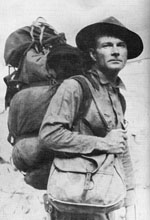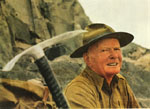|
![]()
1914 was the first year that I did any climbing of any account in the Sierra. Climbing at that time was what mountaineers sometimes term "free climbing." Ropes were seldom used and those that were, were not adequate and probably no one knew anything about the technique of using a rope in climbing. An ice axe was seldom or never seen. Any ice cutting that was done was usually done with some sort of a wood axe. As to foot gear, there was a tendency to wear at least moderately high boots. These were often of a very good grade and their owner was oft times quite proud of them. Often they were provided with Hungarian nails or hobnails. The former were fairly satisfactory until worn flat, so that the wearer was likely to do considerable skating around on smooth rocks.
Later, in the matter of footgear, there was a gradual change from nailed soles to cleated rubber ones, at first to the Bramani design. Somewhat later a further change was made to the Vibram type, which came near to being an all-around satisfactory mountain climbing boot than any other boot yet produced. Climbers, who encountered much ice and snow may supplement these with crampons. Today, climbers in the High Sierra may be roughly divided into several groups. One group, which may be the walkers, seldom goes past Class 2 climbing. These often do not carry rope. Another group is satisfied with Class 3 and Class 4 grades, seldom going beyond. These usually do and always should carry a rope and often carry along a few pitons and carabiners, to help themselves over a difficult pitch. If there is snow and ice, they add an ice axe. Lastly, are the technical rock climbers, who are not happy unless they encounter a liberal measure of Class 5 and Class 6 pitches. All forms are legitimate, if proper safety measures are followed. There is room for all. Some may not think "hardware climbing" is justified on account of the supposed risks involved. Properly equipped and careful climbers, however incur less dangerous exposure on Class 5 and Class 6 routes than untrained men inadvertently may on Class 3, or even Class 2. Everyone to his taste. "De gustibus non disputandum est, as the old Latin proverb goes.
|
|
is available through: Spotted Dog Press Inc. - Coons Gallery 2399 N. Sierra Highway Bishop CA 93514 760-872-1524 |
Avalanches are much more numerous in the High Sierra during the winter and spring than those who have not spent considerable time there are aware. Their number varies greatly much more frequent and of greater volume during seasons of high precipitation. That comparatively slight damage has been done to property and few lives lost is due, in large measure, to the fact that most occur when there is little property to destroy and no person in the pathway. With the annual increase of visitors to the Sierra for skiing and climbing, the hazard to life and limb is enhanced, particularly to those who do not know when or where slides may occur. Those who do may not come to grief in a single season.  Snowslides in the higher portions of the mountains take place most frequently in couloirs or chutes. After heavy snowfalls, numerous slides course down. They are most likely in winter or within the day following a storm. In spring, after a storm, almost as soon as the sunshine strikes new snow, it may let go and come rushing down the couloir. After a storm in May, I have seen as many as a dozen slides coursing down as many couloirs in beautiful snowfalls. Avalanches take place on smooth slopes on steep mountain faces. Powder snow does not cling to these faces. If it happens to be wet, as sometimes happens, even in the High Sierra, a considerable amount may adhere to the rocks. As the temperature warms this usually sloughs off in avalanches. During winters of heavy snowfall, slides may occur in unexpected places. They may even comedown rough south-facing slopes where slides seldom or never take place during winters of normal snowfall. Snowslides may sweep all the snow down to the underlying rocks, perhaps taking along the rocks. Then the avalanche gives a crashing sound as it goes plunging down. If composed almost entirely of snow, it may only give a hissing sound, audible for no great distance. If of powder snow and the volume is great, a cloud of flying snow will be carried high into the air.  Many slides do not reach the underlying terrain. Except on protected slopes or basins, snow that falls in the Sierra may be packed by the wind or thaw on the surface. As the temperature drops, a crust is formed. If alternate thawing and freezing continues, neve, or granular snow is formed. By spring, much of the snow, particularly on exposed slopes is of this form. Rough slopes which would prevent snow from sliding are sometimes smoothed over. Should a heavy snow fall on such a surface, particularly if the slope is above 45°, the danger of a slide is great. Many of the spring slides are of this type. Often these are not dangerous unless one happens to be in a confined space, such as a couloir, or if they happen to be a sheet - slide so wide that one cannot get beyond their margin. Slides in the Sierra are likely to be narrow. After a storm, I have seen numerous ones of new snow come down, each making a peculiar hissing sound. I have skied across the path of one and, wheeling, watched the slide sweep with its peculiar sliding rolling motion. Avalanches usually start slowly. A crack runs along, then slowly widens and a sheet of snow begins to move. Once started, the acceleration may be great. If it travels three thousand feet down a steep slope, it may reach express-train speed. Its momentum being sufficient, it may run across several hundred yards of terrain at the foot. If the slide results from a collapsing cornice, it may, however, simply go plunging down the mountainside. Generally, there is little danger to one who knows when and where snowslides may occur. In many years of rambling about at high elevations, only on two occasions did I incur any such danger. Once, after climbing through a notch on the upper rim of a cliff and entering a couloir, I stepped to one side. As I did so, I heard a swishing sound, and an avalanche swept down the notch through which I had just climbed. On another occasion, weary of slogging through wet snow well up to my knees, I hit upon the idea of starting miniature snowslides and riding them. This I did by sitting down heavily, causing the layer of new snow to begin to slide. The acceleration was rapid. Eventually I struck a shadowed area, where an icy crust had formed. Instantly, the slide shot forward, with a cliff only a short distance ahead. By swimming and rolling, I managed to get off the slide and watched it vanish over the cliff. That was the last time that I deliberately rode a snowslide.  |
Selected Writings of Norman Clyde
|
|
|
|
|
(Automobile Club of Southern California Publication) |
A
May Day Ascent of Mt. Whitney Mountaineering in the Sierra Nevada Scaling Mount Humphreys The Ascent of Mount Darwin The First Ascent of Mt. Mallory and Mt. Irvine "Close Ups" of our High Sierra To the Summit On Snowshoes in the Sierra Climbing Glacier's Highest Peak An Ascent of the Grand Teton Mountaineering in the Canadian Rockies Canyons of the Southern Sierras High-Low Along the Sierran Crestline Up the Middle Palisade Up the East Face of Whitney Over the Crests of Southland Urban Mountains The Conquest of Lower California's Highest Peak Over the Sierra from Sequoia to Whitney |
June,
1927 July, 1927 August, 1927 November, 1927 March, 1928 April-July, 1928 November, 1928 March, 1929 July, 1929 September, 1929 October, 1929 August, 1930 November, 1930 May, 1931 August, 1931 December, 1931 April, 1932 September, 1932 July, 1932 |
|
(Automobile Club of Southern California Publication) |
Death
on a Mountain Top Wintering on Yosemite's Crag Glaciers of the Sierra Nevada Up Mount Shasta from the East Mountain Sheep of the Sierra Ramble on Sierran Trails Climbing El Picacho del Diablo Skiing to Winter Summits Holing Up for a Sierran Winter Above the Timber Line Up Bear Creek Spire in a Summer Storm Weather-Wise Buck |
May,
1934 January, 1935 September, 1935 April, 1936 June, 1937 September, 1938 November, 1938 February, 1940 February, 1941 June, 1941 July, 1941 January, 1942 |
|
(Sierra Club Publication) |
Ascent
of Mount Merritt Mountaineering in the Rockies The First Ascent of Mount Russell Climbing the Sierra Nevada from Owens Valley The Sierra Club Ascent of Mount Geike The First Ascent of Mt. Humphreys from the East Skiing and Climbing in the Headwaters of Bishop Creek |
1925 1927 1927 February, 1928 February, 1929 February, 1936 April, 1938 |
|
|
High
Sierra Avalanches Thunderstorms in the Sierra Nevada |
February,
1961 July-August 1961 |
|
|
High Sierra Pack Stations | |
|
|
Willie A. Chalfant | |
|
|
Manzanar Town | |
|
|
More
Norman Clyde |
|
|
Packing, 50 Years Ago |
|
|
|
Fr. John J. Crowley |
|
|
|
Lone Pine-to-Porterville High Sierra Road |
|
Sign Guestbook View Old Guest Book Entries Oct 1999 - Feb 2015 (MS Word) |
 CONTACT the Pigmy Packer |
View Guestbook View Old Guest Book Entries Oct 1999 - Feb 2015 (PDF) |

